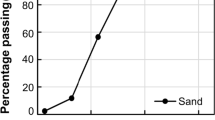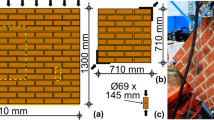Abstract
An important factor affecting the strength of a masonry wall is the capacity of the bond between the mortar and the bricks to transfer the loads within the wall. The main parameter influencing the bond strength is the moisture content of the brick units and the consistency of mortar paste at the time of construction. Another important, but little known, factor is the post-construction moisture curing of the wall. In this paper, the results of a series of standard tests, aimed at determining the effects of moisture condition on the flexural strength, direct tensile bond strength, shear bond strength, compressive strength and diagonal shear strength of brick masonry are presented. The results indicate a substantial increase in the bond strength when saturated, surface dry, brick units are used and show the favorable effects of post-construction water curing of brickwork. Also, in-plane shear and out-of-plane bending tests are carried out on a number of brick wallets and infills, constructed with different pre and post construction moisture conditions and results are compared to drive at quantitative conclusions on the effects of pre-wetting the brick units at the time of construction and post-construction moisture curing on the behavior and strength properties of brick wall construction.

















Similar content being viewed by others
References
Razani R, Lee KL (1973) The engineering aspects of the Qir earthquake of 10 April 1972 in southern Iran. National Academy of Engineering Committee on Natural Disasters, Washington, DC
Maheri MR (1992) Manjil, Iran earthquake of June 1990, some aspects of structural response. J Struct Eng Rev 4(1):1–16
Maheri MR, Naeim F, Mehrain M (2005) Performance of adobe residential buildings in the 2003 Bam, Iran, earthquake. Earthq Spectra 21(S1):S337–S344
Lange DA, Deford HD, Ahmed A (1996) Microstructure and mechanisms of bond in masonry. In: Proceedings of the seventh North American Masonry conference, University of Norte Dame, Indiana, USA, pp 167–174
Hendry AW, Sinha BP, Davies SR (1997) Design of masonry structures. E & FN Spon, London
McGineley WM (1990) IRA and the flexural bond strength of clay brick masonry. In: Matthys JH (ed) Masonry: components to assemblage. ASTM STP 1063, pp 217–234
Kunzel HM (1998) Effect of interior and exterior insulation on the hydrothermal behavior of exposed walls. Mater Struct 31:99–103
Groot CJWP, Gunneweg J (2004) Water permeance problems in single wythe masonry walls: the case of wind mills. Construct Build Mater 18:325–329
Cultrone G, Sebastian E, Ortega Huertas M (2007) Durability of masonry systems: a laboratory study. Construct Build Mater 21:40–51
Terheiden K (2008) Simultaneous measurement of vapor and liquid moisture transport in porous building materials. Build Environ 43:2188–2192
Yorkdale AH (1982) Initial rate of absorption and mortar bond. In: Borchelt JG (ed) Masonry: materials, properties and performance. ASTM STP 778, American Society for Testing and Materials, pp 91–98
Gooduin JF, West WH (1982) A review of the literature on brick/mortar bond. Proc Br Ceram Soc 30(23):23–37
Lawrence SJ, Cao S (1994) The influence of some factors on the tensile bond strength of masonry. In: Shrive NG, Huizer A (eds) Proceedings of the 10th international brick and block masonry conference (IB2 MaC), Calgary, Canada, pp 929–938
Sarangapani G, Venkatarama Reddy BV, Jagadish KS (2005) Brick-mortar bond and masonry compressive strength. J Mater Civil Eng 17(2):229–237
Forth JP, Brooks JJ, Tapsir SH (2000) The effect of unit water absorption on long-term movements of masonry. Cem Concr Compos 22:273–280
Ince C, Carter MA, Wilson MA, El-Turki A, Ball RJ, Allen GC, Collier NC (2010) Analysis of the abstraction of water from freshly mixed jointing mortars in masonry construction. Mater Struct 43(7):985–992
Brocken HJP, Spiekman ME, Pel L, Kopinga K, Larbi JA (1998) Water extraction out of mortar during brick laying: a NMR study. Mater Struct 32:49–57
Manfredi G, Mazzolani S (1992) Review of existing in experimental testing of masonry structures subjected to horizontal loads. In: Proceedings of the 10th world conference on earthquake engineering, Madrid, pp 3557–3562.
Magenes G, Calvi GM (1997) In-plane seismic response of brick masonry walls. Earthq Eng Struct Dyn 26:1091–1112
Gabor A, Ferrier E, Jacquelin E, Hamelin P (2006) Analysis and modeling of the in-plane shear behavior of hollow brick panels. Construct Build Mater 20(5):308–321
Tomazevic M (2009) Shear resistance of masonry walls and Eurocode 6: shear versus tensile strength of masonry. Mater Struct 42(7):889–907
Sinha BP, Ng CL, Pedreschi RF (1997) Failure criterion and behavior of brickwork in biaxial bending. J Mater Civ Eng 9(2):70–75
Griffith MC, Lam NTK, Wilson JL, Doherty K (2004) Experimental investigation of unreinforced brick masonry walls in flexure. J Struct Eng 130:423–432
Abrams DP, Angel R, Uzarski J (1996) Out-of-plane strength of unreinforced masonry infill panels. Earthq Spectra 12(4):825–844
Reda Taha MM, El-Dieb AS, Shrive NG (2001) Sorptivity: a reliable measurement for surface absorption of masonry brick units. Mater Struct 34:438–445
ASTM standards in building codes. 42nd edn, vol 2, 2005, USA
ASTM E519-81 (1981) Standard test method for diagonal tension (shear) in masonry assemblages. ASTM International, USA
Mulligan JA (1942) Handbook of brick masonry construction. McGraw-Hill, London
ASTM C1531-09 (2009) Standard test method for in-situ measurement of masonry mortar joint shear strength index. ASTM International, USA
Mayes RL, Clough RW (1975) State-of-the-art in seismic shear strength of masonry-an evaluation and review. EERC 75-21, College of Engineering, University of California
Acknowledgment
The authors wish to acknowledge the financial support provided for the work presented here by the Researchers’ Support Fund of Iran under Grant No. 84/3477.
Author information
Authors and Affiliations
Corresponding author
Rights and permissions
About this article
Cite this article
Maheri, M.R., Motielahi, F. & Najafgholipour, M.A. The effects of pre and post construction moisture condition on the in-plane and out-of-plane strengths of brick walls. Mater Struct 44, 541–559 (2011). https://doi.org/10.1617/s11527-010-9648-y
Received:
Accepted:
Published:
Issue Date:
DOI: https://doi.org/10.1617/s11527-010-9648-y




